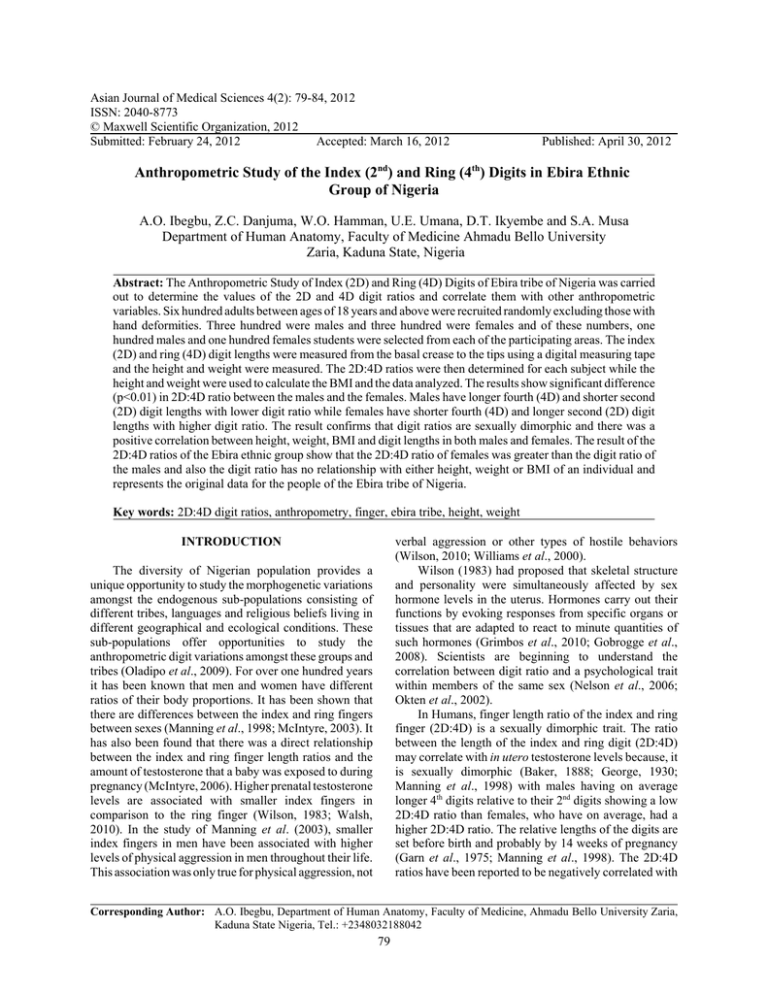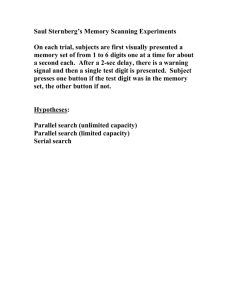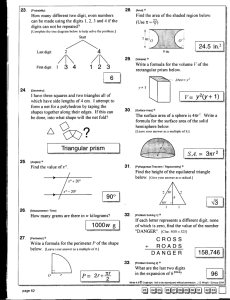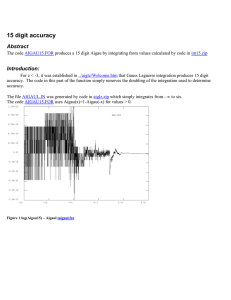
Asian Journal of Medical Sciences 4(2): 79-84, 2012
ISSN: 2040-8773
© Maxwell Scientific Organization, 2012
Submitted: February 24, 2012
Accepted: March 16, 2012
Published: April 30, 2012
Anthropometric Study of the Index (2nd) and Ring (4th) Digits in Ebira Ethnic
Group of Nigeria
A.O. Ibegbu, Z.C. Danjuma, W.O. Hamman, U.E. Umana, D.T. Ikyembe and S.A. Musa
Department of Human Anatomy, Faculty of Medicine Ahmadu Bello University
Zaria, Kaduna State, Nigeria
Abstract: The Anthropometric Study of Index (2D) and Ring (4D) Digits of Ebira tribe of Nigeria was carried
out to determine the values of the 2D and 4D digit ratios and correlate them with other anthropometric
variables. Six hundred adults between ages of 18 years and above were recruited randomly excluding those with
hand deformities. Three hundred were males and three hundred were females and of these numbers, one
hundred males and one hundred females students were selected from each of the participating areas. The index
(2D) and ring (4D) digit lengths were measured from the basal crease to the tips using a digital measuring tape
and the height and weight were measured. The 2D:4D ratios were then determined for each subject while the
height and weight were used to calculate the BMI and the data analyzed. The results show significant difference
(p<0.01) in 2D:4D ratio between the males and the females. Males have longer fourth (4D) and shorter second
(2D) digit lengths with lower digit ratio while females have shorter fourth (4D) and longer second (2D) digit
lengths with higher digit ratio. The result confirms that digit ratios are sexually dimorphic and there was a
positive correlation between height, weight, BMI and digit lengths in both males and females. The result of the
2D:4D ratios of the Ebira ethnic group show that the 2D:4D ratio of females was greater than the digit ratio of
the males and also the digit ratio has no relationship with either height, weight or BMI of an individual and
represents the original data for the people of the Ebira tribe of Nigeria.
Key words: 2D:4D digit ratios, anthropometry, finger, ebira tribe, height, weight
verbal aggression or other types of hostile behaviors
(Wilson, 2010; Williams et al., 2000).
Wilson (1983) had proposed that skeletal structure
and personality were simultaneously affected by sex
hormone levels in the uterus. Hormones carry out their
functions by evoking responses from specific organs or
tissues that are adapted to react to minute quantities of
such hormones (Grimbos et al., 2010; Gobrogge et al.,
2008). Scientists are beginning to understand the
correlation between digit ratio and a psychological trait
within members of the same sex (Nelson et al., 2006;
Okten et al., 2002).
In Humans, finger length ratio of the index and ring
finger (2D:4D) is a sexually dimorphic trait. The ratio
between the length of the index and ring digit (2D:4D)
may correlate with in utero testosterone levels because, it
is sexually dimorphic (Baker, 1888; George, 1930;
Manning et al., 1998) with males having on average
longer 4th digits relative to their 2nd digits showing a low
2D:4D ratio than females, who have on average, had a
higher 2D:4D ratio. The relative lengths of the digits are
set before birth and probably by 14 weeks of pregnancy
(Garn et al., 1975; Manning et al., 1998). The 2D:4D
ratios have been reported to be negatively correlated with
INTRODUCTION
The diversity of Nigerian population provides a
unique opportunity to study the morphogenetic variations
amongst the endogenous sub-populations consisting of
different tribes, languages and religious beliefs living in
different geographical and ecological conditions. These
sub-populations offer opportunities to study the
anthropometric digit variations amongst these groups and
tribes (Oladipo et al., 2009). For over one hundred years
it has been known that men and women have different
ratios of their body proportions. It has been shown that
there are differences between the index and ring fingers
between sexes (Manning et al., 1998; McIntyre, 2003). It
has also been found that there was a direct relationship
between the index and ring finger length ratios and the
amount of testosterone that a baby was exposed to during
pregnancy (McIntyre, 2006). Higher prenatal testosterone
levels are associated with smaller index fingers in
comparison to the ring finger (Wilson, 1983; Walsh,
2010). In the study of Manning et al. (2003), smaller
index fingers in men have been associated with higher
levels of physical aggression in men throughout their life.
This association was only true for physical aggression, not
Corresponding Author: A.O. Ibegbu, Department of Human Anatomy, Faculty of Medicine, Ahmadu Bello University Zaria,
Kaduna State Nigeria, Tel.: +2348032188042
79
Asian J. Med. Sci.,4(2): 79-84, 2012
testosterone levels and positively associated with estrogen
levels in adults (Manning et al., 1998; Manning and
Taylor, 2001). The sex differences in 2D:4D ratio is
present before birth in human, which rules out any social
influences that might affect digit growth differentially in
the two sexes. All somatic sex differences in mammals to
date have been found to be due to either androgenic
masculinization or effects of the sex chromosomes (Fink
et al., 2006; Malas et al., 2006). The Androgen
Insensitivity Syndrome (AIS) finding rules out a role for
sex chromosomes in the sex differences in digit ratios and
the prenatal sexual dimorphism indicates that androgens
act before birth to affect digit ratios (Paul et al., 2006;
Fink et al., 2004b).
Anatomically, the ring finger is the fourth digit of the
human hand and the second most ulnar finger located
between the middle finger and the little finger (Arthur
et al., 1998; Fink et al., 2004a) while the index finger also
referred to as forefinger, is the first finger and the second
digit of a human hand. It is located between the thumb
and the middle finger. It is usually the most dexterous and
sensitive f inger of the hand (Arthur et al., 1998; Fink
et al., 2004b). It has been shown that men have relatively
shorter index fingers than the ring fingers (Burriss et al.,
2007; Brown et al., 2002; Neave et al., 2003). Men with
more masculine finger ratios are perceived as being more
masculine and dominant by female observers and tend to
perform better in a number of physical sports (Neave
et al., 2003; Churchill et al., 2007; Lutchmaya et al.,
2004). A low 2D:4D ratio has been shown to correlate
with high testosterone levels which is characteristic of
males, while a high 2D:4D ratio is correlated with low
testosterone level, a characteristic of females (Manning,
2002). The aim of the present study is to study the
anthropometric differences in the 2nd and 4th digit ratios in
Ebira people of Nigeria.
Fig. 1: shows the females digit length
METHODOLOGY
Subjects: The population of study consists of Students of
the Ebira ethnic extraction of Okene Local Government
Area of Kogi State-Nigeria. Three Secondary Schools
were randomly selected from the list of Secondary
Schools in Okene Local Government Area. The Schools
selected were Ebira Community Secondary School
Ogaminana Okene, Adavi Local Government Science
Secondary School Nagazi Eba and Government Science
Secondary School Ogaminana. The study was carried out
on a cross sectional sample of 600 adult students for the
study. Three hundred (300) of the respondents were males
while the remaining 300 were females, of these, one
hundred males and one hundred females were selected
from each of the participating schools. Data on age, sex,
ethnic background were collected through oral interview
and structured questionnaire as primary data collection
and the Anthropometric measurements as secondary data
collection.
Fig. 2: shows the males digit length.
Sample size and sample techniques: A total of 600
Ebira adults of age between 18 years and above were used
for the study. The sample comprised of 300 normal Ebira
males and 300 Ebira females. The subjects were selected
at random and were purely Ebiras by both parents and
grandparents. The length of the second digits (2D) and
fourth digits (4D) of the left and right hand of each
subject were measured with the aid of a digital measuring
tape from the tip of the digit to the ventral proximal crease
as show in Fig. 1 and 2 where there was a band of crease
at the base of the digit, the most proximal crease was used
(Fink et al., 2004a, b). Subjects with injuries or
deformities in any of the hands were excluded from the
study. All measurements were made carefully with digits
fully extended. The data used for the research study was
80
Asian J. Med. Sci.,4(2): 79-84, 2012
collected in the three Schools in Okene area of Ebira land
of Kogi State of Nigeria and analyzed in the Ahmadu
Bello University Department of Human Anatomy between
August and November 2011, under the supervision of the
first Author.
8.2
8.0
1 = 2D Males
2 = 2D Females
3 = 4D Males
4 = 4D Females
7.8
7.6
7.4
7.2
Instrumental design: The instrument used for the study
was a structured questionnaire titled ‘’Questionnaire on
Anthropometric Study of the Index (2nd) and Ring (4th)
Digits in Ebira Ethnic Nationality of Nigeria’’ that was
developed on the basis of Manning et al. (1998) and
Manning et al. (2000). The questionnaires consist of two
sections. Section one is made up of personal demographic
information with questions on the lineage of the
respondents, while section two contained information on
anthropometric measurements.
7.0
6.8
6.6
6.4
1
2
3
4
Fig. 3: Show the differences in the length of 2D:4D in Ebira
males and females
0.945
0.945
Method of validation of instruments: Three parameters
were investigated which includes height, weight and the
length of index (2ndD) and ring (4thD) of both hands.
Medical terminologies were not introduced in the
questionnaire appropriate to make it clearer to the
respondent at all level. Careful and appropriate steps were
taken to protect the rights of the respondents. Potential
respondents were informed that the survey was
completely voluntary and all participation was
confidential. All information through oral interview was
collected from the respondents and were compared and
analyzed.
1 = 2D/4D ratio in Males
2 = 2D/4D ratio in Females
0.940
0.935
0.930
0.925
0.920
1
2
Fig. 4: Show the difference in 2D:4D ratios betwwen Ebira
males and Females
Table 1:Shows the mean, ±SEM of 2D, 4D lengths and the ratios of
2D:4D in males and females of Ebira ethnic group of Nigeria
Parameters Males±SEM Females±SEM t-values Sig. level
R2D
7.43±0.03
7.07±0.03
7.973
p<0.01
L2D
7.43±0.03
7.07±0.03
7.973
p<0.01
R4D
8.03±0.03
7.57±0.03
10.055
p<0.01
L4D
8.03±0.03
7.57±0.03
10.055
p<0.01
R2D:4D
0.93±0.03
0.94±0.03
4.8784
p<0.01
L2D:4D
0.93±0.03
0.94±0.03
4.8784
p<0.001
**: p<0.01 show that statistical significant difference was found with
right 2D, right 4D, left 2D, left 4D, right 2D:4D and left 2D:4D ratio
Sample/statistical analysis: Data was expressed as
Mean±Standard deviation (±SD). Descriptive statistics
and students’ T-test were used to analyze and determine
the parameters studied in both males and females. The
relationship between the parameters studied was
established using Pearson correlation to establish the
strength of the relationship between the lengths of second
and fourth digits (2D & 4D), the digit ratios and the other
Anthropometric variables in both sexes. Statistical
significance was accepted at P value less than or equal to
<0.01 (p<0.01).
Table 2: General statistics of the anthropometric parameters used
Parameters Sex Mean±SD
Min
Max
N
2D:4D
M
0.93±0.03
6.25
950
300
F
0.94±0.03
6.15
9.00
300
Height (unit) M
162.1767±8.26801 144.00
185.00 300
F
155.553±8.6624
53.00
175.00 300
Weight
M
57.523±9.1591
40.00
95.00
300
F
53.453±7.5921
40.00
81.00
300
BMI
M
22.410±3.783
13.89
25.68
300
F
22.600±10.506
23.14
37.75
300
RESULTS
The result of the Anthropometric study of the
differences in index finger (2D), ring finger (4D) and their
ratio shows there was a significant difference between the
lengths of index finger (2D), ring finger (4D) and the
ratios of 2D:4D in both males and females. The mean
values in males are 7.43, 8.03 and 0.93 cm while in
females are 7.07, 7.57 and 0.94 cm, respectively. The
difference in the mean values of the lengths of index
finger (2D), ring finger (4D) and 2D:4D ratios between
the males and females of Ebira ethnic group are
statistically significant (p<0.01) as shown in Table 1 and,
Fig. 3 and 4.
The results show that the mean height (162.17) of
males exceeded the mean height (155.55) of females. The
mean weight (57.52) of males exceeded the mean weight
value (53.45) of females. But the mean BMI (22.60) of
females exceeded the mean BMI (22.41) of males
(Table 2).
Table 3 shows the correlation matrix of the
anthropometric parameters. The result shows a positive
81
Asian J. Med. Sci.,4(2): 79-84, 2012
Table 3: Correlation matrix of the anthropometric parameters used
Males
Females
----------------------------------------------------------------------------------------------------------------------------R2D:4D
BMI
N
R2D:4D
BMI
N
……
0.059
300
……
0.143
300
Height (cm)
0.017
0.611**
300
-0.052
- 0.702**
300
Weight (kg)
0.065
0.959**
300
0.061
0.248**
300
BMI (kg/m2)
0.059
………
300
-0.052
……..
300
**: p<0.01 show significant correlation between height, weight and BMI in both males and females
compared to males. This observation agrees with earlier
reports by George (1930), Manning et al. (1998),
Manning et al. (2001), Manning (2002), Manning et al.
(2003) and Oladipo et al. (2009). This sexual dimorphism
in 2D:4D ratios are influenced by prenatal testosterone
concentrations. This hormone is thought to modify
developmental rate such as epidermal ridges of the digits
during fourth weeks of fetal development (Wallien et al.,
2008; McFadden and Shubel, 2002; Neave et al., 2003;
Manning et al., 2004; Geschwind and Galaburda, 1985).
High concentrations of fetal testosterone indicate a low
2D:4D ratios, which therefore indicate a high prenatal
testicular activity. On the other hand 2D:4D is positively
correlated with oestrogen in men and women (Williams
et al., 2000; Paul et al., 2006; Malas et al., 2006; Putz
et al., 2004).
In Nigeria, digit ratios vary according to the ethnic
groups. Among the Igbos and Urhobos, males have
shorter digit ratios than the females (Oladipo et al., 2009),
while in the Ikwerres and Andonis, males have shorter
digit ratios than the females (Oladipo et al., 2009). The
present study of Ebira ethnic group shows that males have
shorter digit ratios than the females which agrees with the
rest of Nigerian ethnic groups though the values of the
ratios are not the same but they follow similar trends. The
observed ethnic variation was similar to those of Manning
et al. (2003), who reported that 2D:4D shows strong
ethnic differences. The result of the present study suggests
that there is a positive correlation between BMI and
height and BMI and weight, though females have higher
BMI than males. Our study failed to show positive
correlation between the finger length ratios (2D:4D) with
BMI, height and weight of the study population and is
consistent with the early hypothesis that fetal hormones
affect 2D:4D ratios (Martel et al., 2008; Putz et al., 2004;
Richard et al., 2006; Wallien et al., 2008).
correlation (p<0.01) between BMI and height, BMI and
weight, but there was no correlation between BMI and
2D:4D digit ratios.
DISCUSSION
Determination of Finger length ratio (2D:4D) of
Ebira ethnic group of Nigeria was done and the results
was compared with different anthropometric
measurements both in males and females of adult Ebira
people. Many researchers have attempted these
measurements but the digit ratio values proved to be
consistently reliable in sex dimorphism and it has been
demonstrated that a considerable proportion of normal
males have low digit ratios compared to the females
(Brown et al., 2002). The present study was designed to
establish the relationship between the Male and female
finger length ratios (2D:4D) and to ascertain if it has any
relationship with height, weight and BMI. The results
from the present study show there was a relationship
between 2D:4D ratios in males and females of Ebira
ethnic nationality of Nigeria.
The study done by Manning et al. (2000) showed that
Females had longer second digits than fourth digits while
males have longer fourth digits than second digits. This
accounted for the higher digit ratios in females than in
males. The results of the males and females 2D:4D ratios
however confirmed that digit ratios (2D:4D) are sexually
dimorphic phenomena. It was observed in the present
study that males have longer digits compared to females
which is however not common when compared to other
studies (Galis et al., 2009; Rahman and Wilson, 2003;
Okten et al., 2002; Gobrogge et al., 2008).
It was observed from the present study that second
digit length in Ebira males was shorter than fourth digit
length which was significantly different when compared
with that of the females. This finding agrees with the
reports of George (1930), Manning (1998) and Manning
et al. (2000), who reported that second digits in the males
tend to be shorter than fourth digits. These digits lengths
are influenced by testosterone and estrogen in-utero
(Manning et al., 2000). The observed second digit lengths
for Ebira females was similar to observations of Manning
et al. (1998), Manning (2002) and Manning et al. (2004),
that the second and fourth digit lengths in females are
approximately the same or is like that of males. In the
present study, 2D:4D ratio has been found to be sexually
dimorphic with females having higher digit ratios
REFERENCES
Arthur, R.M., D.G. Beetner, H.D. Ambos and M.E. Cain,
1998. Improved estimation of pericardial potentials
from body-surface maps using individualized torso
models. J. Electrocardiol., 31: 106-113.
Baker, F., 1888. Anthropological notes on the human
hand. Am. Anthropol., 1: 51 75.
Brown, W.M., M. Hines, B.A. Fane and S.M. Breedlove,
2002. Masculinized finger length patterns in human
males and females with congenital adrenal
hyperplasia. Horm. Behav., 42(4): 380-386.
82
Asian J. Med. Sci.,4(2): 79-84, 2012
Burriss, R.P., A.C. Little and E.C. Nelson, 2007. 2D: 4D
and sexually dimorphic facial characteristics. Arch.
Sex. Behav., 36(3): 377-384.
Churchill, A.J.G., J.T. Manning and M. Peters, 2007. The
effects of sex, ethnicity and sexual orientation on
self-measured digit ratio (2D:4D). Arch. Sex. Behav.,
36(2): 251-260.
Fink, B., J.T. Manning, N. Neave and U. Tan, 2004a.
Second to fourth digit ratio and hand skill in Austrian
children. Biol. Psychol., 67(3): 375-384.
Fink, B., J.T. Manning, N. Neave and K. Grammer,
2004b. Second to fourth digit ratio and facial
asymmetry. Evol. Hum. Behav., 25(2): 125-132.
Fink, B., J.T. Manning and N. Neave, 2006. The 2nd-4th
digit ratio (2D: 4D) and neck circumference:
Implications for risk factors in coronary heart
disease. Int. J. Obesity, 30(4): 711-714.
Galis, F., C.M. Ten Broek, S. Van Dongen and
L.C. Wijnaendts, 2009. Sexual dimorphism in the
prenatal digit ratio (2D:4D). Arch. Sex. Behav.,
38(1): 57-62.
Garn, S.M., A.R. Burdi, W.J. Babler and S. Stinson,
1975. Early prenatal attainment of adult metacarpalphalangeal rankings and proportions. Am. J. Phys.
Anthropol., 43(3): 327-332.
George, R., 1930. Human finger types. Anat. Rec., 46:
199-204.
Geschwind and Galaburda, 1985. Cerebral laterization.
Biological mechanics association and pathology: A
hypothesis and a program for research. Arch.
Neurol., 43: 428-654.
Gobrogge, K.L., S.M. Breedlove and K.L. Klump, 2008.
Genetic and environmental influences on 2d:4d
finger length ratios: A study of monozygotic and
dizygotic male and female twins. Arch. Sex. Behav.,
37(1): 112-118.
Grimbos, T., K. Dawood, R.P. Burriss, K.J. Zucker and
D.A. Puts, 2010. Sexual orientation and the second to
fourth finger length ratio: A meta-analysis in men
and women. Behav. Neurosci., 124(2): 278-287.
Lutchmaya, S., S. Baron-Cohen, P. Raggatt,
R. Knickmeyer and J.T. Manning, 2004. 2nd to 4th
digit ratios, fetal testosterone and estradiol. Early
Hum. Dev., 77(1-2): 23-28.
Malas, M.A., S. Dogan, E.H. Evcil and K. Desdicioglu,
2006. Fetal development of the hand, digits and digit
ratio (2D:4D). Early Hum. Dev., 82(7): 469-475.
Manning, J.T., D. Scutt, J. Wilson and D.I. Lewis-Jones,
1998. The ratio of 2nd to 4th digit length: A predictor
of sperm numbers and concentrations of testosterone,
luteinizing hormone and oestrogen. Hum. Reprod.,
13(11): 3000-3004.
Manning, J.T., L. Barley and J. Walton, 2000. The
2nd:4th digit ratio, sexual dimorphism, population
differences and reproductive success: Evidence for
sexually antagonistic genes?. Evol. Hum. Behav.,
21(3): 163-183.
Manning, J.T. and R.P. Taylor, 2001. Second to fourth
digit ratio and male ability in sport: Implications for
sexual selection in humans. Evol. Hum. Behav.,
22(1): 61-69.
Manning, J.T., S. Baron-Cohen, S. Wheelwright and
G. Sanders, 2001. The 2nd to 4th digit ratio and
autism. Dev. Med. Child Neurol., 43(3): 160-164.
Manning, J., 2002. Digit Ratio: A Pointer to Fertility,
Behavior and Health. New Brunswick, Rutgers
University Press, N.J.
Manning, J.T., P.E. Bundred, D.J. Newton and
B.F. Flanagan, 2003. The second to fourth digit ratio
and variation in the androgen receptor gene. Evol.
Hum. Behav., 24: 399-405.
Manning, J.T., A. Stewart, P.E. Bundred and
R.L. Trivers, 2004. Sex and ethnic differences in 2nd
to 4th digit ratio of children. Early Hum. Dev., 80(2):
161-168.
Martel, M.M, K.L. Gobrogge, S.M. Breedlove and
J.T. Nigg, 2008. Masculinized finger length ratios of
boys, but not girls, are associated with attentiondeficit/hyperactivity disorder. Behav. Neurosci.,
122(2): 273-281.
McFadden, D. and E. Shubel, 2002. Relative lengths of
fingers and toes in human males and females.
Hormones Behav., 42(4): 492-500.
McIntyre, M.H., 2003. Digit ratios, childhood gender role
behavior and erotic role preferences of gay men.
Arch. Sex. Behav., 32(6): 495-496.
McIntyre, M.H., 2006. The use of digit ratios as markers
for perinatal androgen action. Reprod. Biol.
Endocrinol., 4: 10.
Neave, N., S. Laing, B. Fink and J.T. Manning, 2003.
Second to fourth digit ratio, testosterone and
perceived male dominance. Proc. Biol. Sci.,
270(1529): 2167-2172.
Nelson, E.C., J.T. Manning and A.G.M. Sinclair, 2006.
Using the length of the 2nd to 4th digit ratio (2D:4D)
to sex cave art hand stencils: Factors to consider.
Before Farming, 1(6): 1-7.
Okten, A., M. Kalyoncu and N. YariÕ, 2002. The ratio of
second-and fourth-digit lengths and congenital
adrenal hyperplasia due to 21-hydroxylase
deficiency. Early Hum. Dev., 70(1-2): 47-54.
Oladipo, S.G., B.H. Fawehinmi, E. Ezon-Ebidor,
A.E. Osunwoke and K.S. Ordu, 2009. Second to
fourth digit ratio in Nigerian Igbos and Yorubas. Sci.
Res. Essays, 4(10): 1146-1148.
Paul, S.N., B.S. Kato, J.L. Hunkin, S. Vivekanandan and
T.D. Spector, 2006. The big finger: The second to
fourth digit ratio is a predictor of sporting ability in
women. Brit. J. Sport. Med., 40(12): 981-983.
Putz, D.A., S.J.C. Gaulin, R.J. Sporter and
D.H. McBurney, 2004. Sex hormones and finger
length: What does 2D: 4D indicate? Evol. Hum.
Behav., 25(3): 182-99.
83
Asian J. Med. Sci.,4(2): 79-84, 2012
Rahman, Q. and G.D. Wilson, 2003. Sexual orientation
and the 2nd to 4th finger length ratio: Evidence for
organising effects of sex hormones or developmental
instability? Psychoneuroendocrino, 28(3): 288-303.
Richard, D., McAnulty and M. Michele Burnette, 2006.
Sex and Sexuality. Greenwood Publishing Group, 1:
165.
Wallien, M.S., K.J. Zucker, T.D. Steensma and
P.T. Cohen-Kettenis, 2008. 2D: 4D finger-length
ratios in children and adults with gender identity
disorder. Horm. Behav., 54(3): 450-454.
Walsh, F., 2010. Index Finger Length Prostate Cancer
Clue. BBC News, Retrieved from: http://www.bbc.
co.uk/news/health-11880415, (Accessed on:
December 01, 2010).
Williams, T.J., M.E. Pepitone and S.E. Christensen, 2000.
Finger-length ratios and sexual orientation. Nature,
404(6777): 455-456.
Wilson, G.D., 1983. Finger-length as an index of
assertiveness in women. Pers. Indiv. Differ., 4(1):
111-112.
Wilson, G., 2010. Fingers to feminism: The rise of
2D:4D. Q. Rev. Chem. Soc., 4: 25-32.
84






